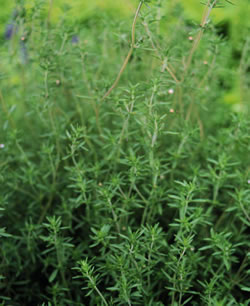Owing to the screen size of your device, you may obtain a better viewing experience by
rotating your device a quarter-turn (to get the so-called "panorama" screen view).
|
This page updated for 2022.
|
Click here for the site directory.
|
|
Please consider linking to this site!
|
Click here to email us.
|
Savory
(Satureja hortensis)
About Savory

The very name tells one something about the qualities of this flavoring, described as having a thyme-like taste but with “an additional, unique touch of peppery piquancy.” Most sources (that is, seedsmen’s catalogues) say that summer savory is slightly milder and less “pungent“ than its close cousin, winter savory (which, however, is a perennial); but the authoritative herbalist Gernot Katzer, quoted above, says the tastes of the two are indistinguishable. (It is said that cooks prefer the summer type.) But if we have summer savory available indoors year round, there is really no need for winter savory.
Cultivars
The named variety Aromata is reported as having more “essential oils“, and thus to be more intensely flavored, than “common“ summer savory; but it is scarce (we could find only one offer in the U.S.). Few or no other named types seem in evidence. (Aromata may be the kind labelled by some seed houses as “Compact”—which would slightly increase the number of offers.)
Planting
Note: summer-savory seed is short-lived. Always plant with fresh, newly bought seed. (But, as noted farther below, once grown it freely self-seeds and so is, in a sense, a “perennial”.)
Summer savory is not terribly fussy, but its ideal is a rich, light soil with plenty of moisture and a hot, dry, sunny position. It prefers a slightly alkaline soil, but, again, is not fussy; it is, though, like so many herbs, intolerant of damp soils and of shade.
Whether growing it indoors or out, seed it where it is to grow: it violently dislikes being transplanted. Sow seed carefully: just place it on the surface, then gently sift a trace of soil over it to just cover. Plants can be spaced as close as 6" (at least in a deep-dug bed), but perhaps allow a little extra for seedfall. (If being planted outdoors, summer savory can be spaced at 6 inches in a deep-dug bed.) Germination is typically about 2 weeks.
Growing
Summer savory is a fast-growing plant: it can be harvested within 2 months of sowing. When the plant reaches a reasonable height, pinch off the growing points; that will encourage bushing and increase productivity. Harvesting frequently (even if you don’t actually need some at a given time) is advised, to keep the plant fresh and productive.
If summer savory is cut back as the flower buds appear, it will supposedly produce a fresh flush of leaves.
Though it is an annual, it is reported as quite freely self-seeding—“maybe too freely” one grower remarked.
Relevant Links
Besides any links presented above on this page, the following ought to be especially helpful.
Return to the top of this page.
If you find this site interesting or useful, please link to it on your site by cutting and pasting this HTML:
The <a href="https://growingtaste.com/"><b>Growing Taste</b></a> Vegetable-Gardening Site
—Site Directory—
Search this site, or the web
-
Background Information
about the purposes and design of this site
- Site Front Page
-
Introduction

- An Apologia: why one should cultivate one's garden
- Deep-Bed Gardening (forthcoming)
- Container Gardening (forthcoming)
- Vegetarian and Organic Considerations (forthcoming)
-
Recommended Crops for a home garden, by variety
-
Gardening information and aids
-
Miscellaneous Information of interest to the home gardener
Since you're growing your own vegetables and fruits, shouldn't you be cooking them in the best way possible?
Visit The Induction Site to find out what that best way is!
|
If you like good-tasting food, perhaps you are interested in good-tasting wines as well?
Visit That Useful Wine Site for advice and recommendations for both novices and experts.
|

|
This site is one of The Owlcroft Company family of web sites. Please click on the link (or the owl)
to see a menu of our other diverse user-friendly, helpful sites.
|
|
 Like all our sites, this one is hosted at the highly regarded Pair Networks,
whom we strongly recommend. We invite you to click on the Pair link for more information on getting your site or sites hosted on a first-class service.
Like all our sites, this one is hosted at the highly regarded Pair Networks,
whom we strongly recommend. We invite you to click on the Pair link for more information on getting your site or sites hosted on a first-class service.
|
|
All Owlcroft systems run on Ubuntu Linux and we heartily recommend it to everyone—click on the link for more information.
|
Click here to send us email.
Because we believe in inter-operability, we have taken the trouble to assure that
this web page is 100% compliant with the World Wide Web Consortium's
XHTML Protocol v1.0 (Transitional).
You can click on the logo below to test this page!
You loaded this page on
Friday, 18 April 2025, at 21:57 EDT.
It was last modified on Tuesday, 11 January 2022, at 20:29 EST.
All content copyright ©1999 - 2025 by
The Owlcroft Company

